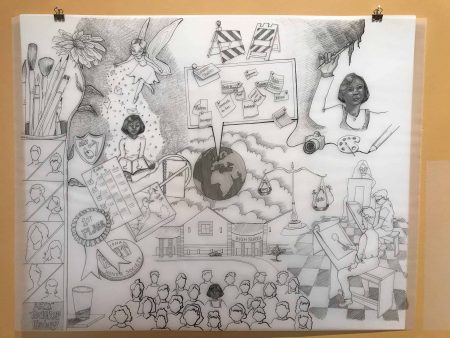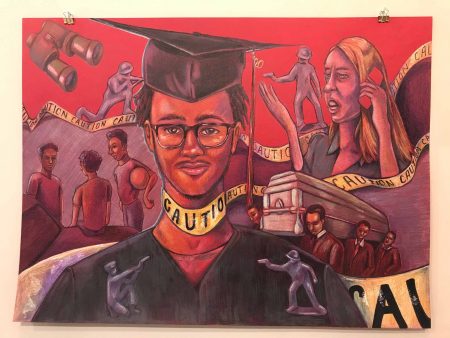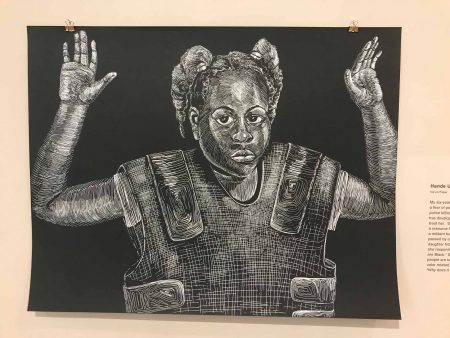Latausha Cox aspires to be an art teacher.
Cox is a recent graduate from DAAP with a degree in art education.
During her art education journey, she recalls her realization of alienation:
“I lacked the opportunity to learn from, about or alongside someone who looked like me. …All my classmates and teachers were White and all art history references came from European so-called Masters.” (Her capitalization and italics)
She further describes her reaction to her journey in art education as feeling “unseen and unsure of how to create meaningful artwork… and found my voice silenced.”

This exhibit of work by Latausha Cox is part of her Master’s thesis at DAAP. The words “illustrative becoming” is her term to describe an auto-ethnic style of drawing through which she explores her personal past experiences for the purpose of understanding her identity.
This exhibition shows illustration technique and a naive style of cartooning, mapping multiple life events with simple drawing materials, colored pencil on paper, ink on commercial vellum and paper supports with selective simple color accents. Gallery presentation is unframed, attached with clips to the gallery wall, avoiding traditional framing formats.
Every wall piece has a paragraph by Cox describing an incident in her life or the life of a family member that reveals the Black life experience. The writing which supports the visual techniques, hopefully enlarges the experience for the viewer.
The exhibit includes a small selection of individual portrait pieces.

“Hands Up” portrays Cox’s six-year old daughter in simple dungarees and short sleeves, drawn in ink on paper. She raises her hands up emerging from a solid black background, her gaze is somber and direct, focused on the viewer. Cox’s copy describes the passing of a police vehicle at her home and the girl hid herself. “She no longer sees police as a resource for safety” because “we are Black”. The figure is scratched from the ink covered surface. This technique is usually executed on a prepared illustration board, hence the term “scratchboard”. It was a popular technique which evolved from woodcut illustration for simple printing forms.
A color pencil work entitled “Caution” depicts Cox’s son and his friends being reported by a “Karen” for gathering near their home to shoot hoops. A softly smiling portrait of Cox’s son in graduation garb dominates the center of the picture. A yellow caution tape wraps around his throat and wanders through the image defining the series of incidents both real and imagined. Plastic grey toy soldiers point their guns toward the graduating candidate and a funeral procession marches on his right shoulder.
Cox’s copy concludes that a police response could result in a funeral, not a graduation celebration.
Another piece talks about her own perceptions about having a darker complexion after loosing a chocolate sale to her lighter-skinned sister “who was cute and deserved his sale more.”
Work, social interactions and everyday incidents are discussed as being experienced as Blackness.
As with the majority of pieces, the sheet is a kind of personal cartography where the images of incidents and symbols hopscotch through space coalescing in a multiple collage effect. Another work seems to diagram the high school art education experience of Ms Cox. A pencil holder containing brushes, pens and pencils has multiple faceless white people, could be classmates, on the side in a ladder-like vertical. Fairy dust falls on a young meditative black girl, a Cox younger self, who stares at an open book with giant question marks on the pages. In another area, only Cox’s blackness has facial features on the crowded path to high school as the rest of the class population are faceless white zombies. The uppermost area shows road blocks over a push-pinned message board with a specific reference to northern Europe. The cloud-born globe floats centrally located in the composition.

In the piece entitled “Future Classroom”, Cox envisions “an atmosphere of dialogue, transparency and reflection”… presenting “curriculum that reaches beyond European history and explores art and artists from various cultures…” Cox feels that with this guidance, those who desire growth will move beyond the limitations of a classroom.
As a result of isolation, quarantine and loss, we are forced to recognize and register our need to be surrounded by people with whom we find basic community and interactive support. It is a disappointing though pervasive reality that our society supports non-inclusivity in many aspects of our business and academic world and social context for many, including women in general.
Recent months have reminded us of the importance of our basic humanity and the inherent value of ALL others. As a result of isolation and loss, we must redefine our need to be surrounded by people and recognize the impact on ourselves, our mental outlook and wellbeing.
Show runs from September 5th to November 7th.
Kennedy Heights Arts Center
6546 Montgomery Rd.
Cincinnati, OH 45213
–Marlene Steele



